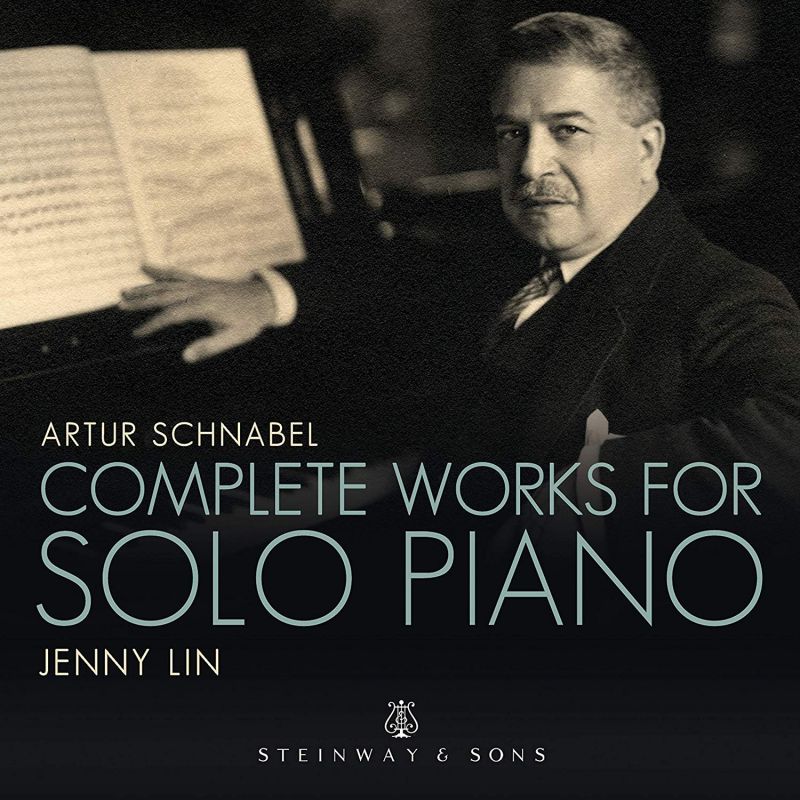SCHNABEL Complete Works for Piano (Jenny Lin)
View record and artist detailsRecord and Artist Details
Composer or Director: Artur Schnabel
Genre:
Instrumental
Label: Steinway & Sons
Magazine Review Date: 08/2019
Media Format: CD or Download
Media Runtime: 141
Mastering:
DDD
Catalogue Number: 30074

Tracks:
| Composition | Artist Credit |
|---|---|
| 3 Fantasy Pieces |
Artur Schnabel, Composer
Artur Schnabel, Composer Jenny Lin, Piano |
| 3 Pieces |
Artur Schnabel, Composer
Artur Schnabel, Composer Jenny Lin, Piano |
| Dance Suite |
Artur Schnabel, Composer
Artur Schnabel, Composer |
| Sonata for Piano (Klavierstück in fünf Teilen) |
Artur Schnabel, Composer
Artur Schnabel, Composer Jenny Lin, Piano |
| Piano Piece in Seven Movements |
Artur Schnabel, Composer
Artur Schnabel, Composer Jenny Lin, Piano |
| 7 Piano Pieces |
Artur Schnabel, Composer
Artur Schnabel, Composer |
| Altwiener Walzer |
Artur Schnabel, Composer
Artur Schnabel, Composer Jenny Lin, Piano |
Author: Patrick Rucker
Thanks to the intrepid Jenny Lin, we now have an overview of Schnabel’s piano music. Lin’s artistry is informed by a curiosity as voracious as it is insatiable. She is also a pianist of the first calibre, with a rock-solid, multivalent technique that serves a richly cultivated imagination. Who knows? She may be just the person to rescue Schnabel’s piano music from the obscurity in which it has languished, virtually since its creation. How could a performer as forward-thinking, perceptive, provocative and widely influential as Schnabel fail to be interesting as a composer as well?
If the earlier works, those up to about 1920, suggest no new paths, they are nevertheless charmingly ingratiating and idiomatically conceived for the instrument. Three Fantasy Pieces, Schnabel’s first published music, originated while he was still a pupil of Leschetizky, to whom they are dedicated. Along with the Three Piano Pieces, Op 15, composed eight years later, they are strongly influenced by Brahms, though a droll sense of humour marks them as uniquely Schnabel’s own.
Things start to get really interesting with the Dance Suite (1921) and the formidable Sonata (1923). Although all five movements of the Sonata are composed without bar lines, indications for tempo, dynamics and expression are abundant (and will surprise no one with a nodding acquaintance of Schnabel’s edition of the Beethoven sonatas). Its advanced harmonic language and strong expressive power suggest that it may be, of all these works, most worthy of revival. Piece in Seven Movements from the mid-1930s and the 1947 Seven Piano Pieces advance and extend the abstract expressionist frontiers of the Sonata.
Of course, a full-scale revaluation of Schnabel’s creative output presupposes familiarity with all his music. And there’s a great deal of it – three symphonies, other orchestral works including a piano concerto, five string quartets, a piano quintet, a piano trio, a string trio, a sonata for violin and piano, two solo sonatas, one each for violin and cello, and many highly effective songs. Lin’s imaginative interpretations make a strong case for the continued viability of Schnabel’s music for the instrument he understood so well.
Discover the world's largest classical music catalogue with Presto Music.

Gramophone Digital Club
- Digital Edition
- Digital Archive
- Reviews Database
- Full website access
From £8.75 / month
Subscribe
Gramophone Full Club
- Print Edition
- Digital Edition
- Digital Archive
- Reviews Database
- Full website access
From £11.00 / month
Subscribe
If you are a library, university or other organisation that would be interested in an institutional subscription to Gramophone please click here for further information.




